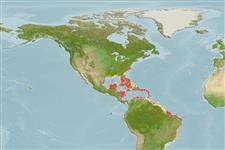Common names from other countries
>
Holocentriformes (Squirrelfishes, soldierfishes) >
Holocentridae (Squirrelfishes, soldierfishes) > Holocentrinae
Etymology: Holocentrus: Greek, holos = full + Greek, kentron = sting (Ref. 45335).
More on author: Walbaum.
Environment: milieu / climate zone / depth range / distribution range
Écologie
marin récifal; profondeur 0 - 32 m (Ref. 3724). Tropical; 36°N - 28°S, 98°W - 31°W
Western Atlantic: Bermuda and southern Florida, USA to northern South America and Brazil; throughout the West Indies (Ref. 3724). Antilles, northwestern Gulf of Mexico, Yucatan to Colombia (Ref. 26938).
Length at first maturity / Taille / Poids / Âge
Maturity: Lm 13.5 range ? - ? cm
Max length : 35.0 cm TL mâle / non sexé; (Ref. 5217); common length : 25.0 cm TL mâle / non sexé; (Ref. 5217)
Épines dorsales (Total) : 11; Rayons mous dorsaux (Total) : 14 - 16; Épines anales: 4; Rayons mous anaux: 9 - 11. Conspicuous white spot behind tip of each dorsal spine (Ref. 26938). Body slender. Upper jaw extending posteriorly to middle of pupil (Ref. 37108). Body bright red or red striped, sometimes blotched (Ref. 7251). Similar in color to H. ascensionis, but each interspinous membrane of dorsal fin with a white spot near margin (Ref. 13442).
Nocturnal (Ref. 37108), inhabits clear reefs (Ref. 5217). Found near mouths of caves and holes (Ref. 26938); at night they usually move to sandy areas and grass beds to feed on crabs, shrimps, gastropods and brittle stars (Ref. 3724). Marketed fresh but not popular as a food fish (Ref. 5217).
Life cycle and mating behavior
Maturities | Reproduction | Spawnings | Egg(s) | Fecundities | Larves
Robins, C.R. and G.C. Ray, 1986. A field guide to Atlantic coast fishes of North America. Houghton Mifflin Company, Boston, U.S.A. 354 p. (Ref. 7251)
Statut dans la liste rouge de l'IUCN (Ref. 130435)
CITES (Ref. 128078)
Not Evaluated
Menace pour l'homme
Reports of ciguatera poisoning (Ref. 30303)
Utilisations par l'homme
Pêcheries: intérêt commercial mineur; Aquarium: Commercial
Outils
Articles particuliers
Télécharger en XML
Sources Internet
Estimates based on models
Preferred temperature (Ref.
115969): 23.9 - 28.1, mean 27.3 (based on 817 cells).
Phylogenetic diversity index (Ref.
82804): PD
50 = 0.7500 [Uniqueness, from 0.5 = low to 2.0 = high].
Bayesian length-weight: a=0.01175 (0.00709 - 0.01948), b=2.89 (2.75 - 3.03), in cm Total Length, based on LWR estimates for this species & (Sub)family-body (Ref.
93245).
Niveau trophique (Ref.
69278): 3.5 ±0.4 se; based on diet studies.
Résilience (Ref.
120179): Haut, temps minimum de doublement de population inférieur à 15 mois (K=0.9).
Fishing Vulnerability (Ref.
59153): Low vulnerability (19 of 100).
